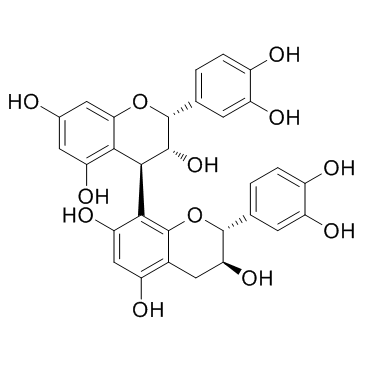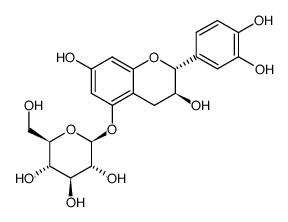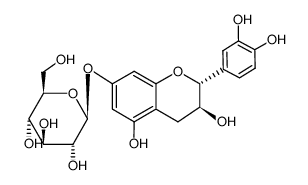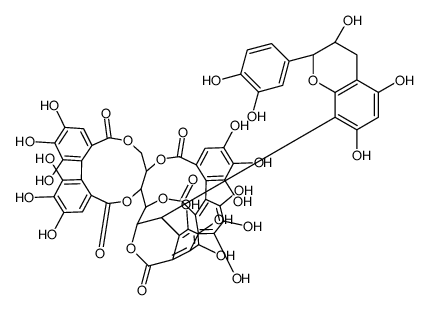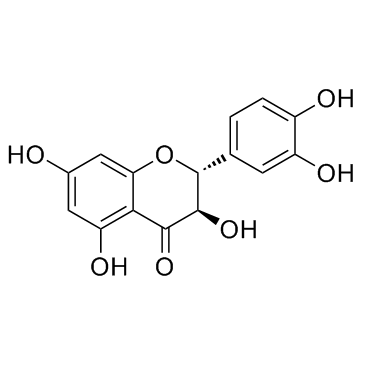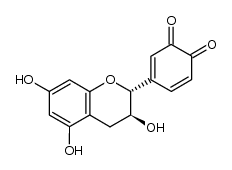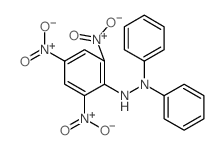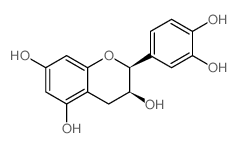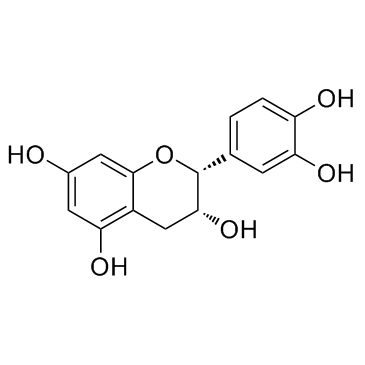154-23-4
| Name | (+)-catechin |
|---|---|
| Synonyms |
(2R,3S)-2-(3,4-dihydroxyphenyl)-3,4-dihydro-2H-chromene-3,5,7-triol
(2R,3S)-2-(3,4-Dihydroxyphenyl)chroman-3,5,7-triol Sunkatol No. 1 (+)-Cianidanol Dexcyanidanol 2H-1-Benzopyran-3,5,7-triol, 2-(3,4-dihydroxyphenyl)-3,4-dihydro-, (2R,3S)- Catechuic acid 3-Cyanidanol, (+)- (+)-(2R:3S)-5,7,3',4'-Tetrahydroxyflavan-3-ol (+)-3,3',4',5,7-Flavanpentol Hydrate Catechin (2R,3S)-2-(3,4-Dihydroxyphényl)-3,4-dihydro-2H-chromène-3,5,7-triol (+)-3,3,4,5,7-Flavanpentol trans-(+)-3,3',4',5,7-Flavanpentol (+)-Cyanidanol-3 (2R,3S)-2-(3,4-Dihydroxyphenyl)-3,5,7-chromanetriol (+)-Catechin Hydrate (2R,3S)-2-(3,4-Dihydroxyphenyl)-3,4-dihydro-2H-1-benzopyran-3,5,7-triol (+)-catechin (2R,3S)-2-(3,4-Dihydroxyphenyl)-3,4-dihydro-2H-chromen-3,5,7-triol Catechinic acid 2H-1-Benzopyran-3,5,7-triol, 2-(3,4-dihydroxyphenyl)-3,4-dihydro-, (2R-trans)- EINECS 205-825-1 (2R,3S)-2-(3,4-Dihydroxyphenyl)chromane-3,5,7-triol Cyanidol D-Catechol |
| Description | Catechin inhibits cyclooxygenase-1 (COX-1) with an IC50 of 1.4 μM. |
|---|---|
| Related Catalog | |
| Target |
COX-1:1.4 μM (IC50) |
| In Vitro | Catechin exhibits >95% inhibitory activity at 70 μg/mL against cyclooxygenase-1 (COX-1) with an IC50 of 1.4 μM[1]. A dose-dependent reduction in color is observed after 24 hours of treatment with Catechin, and 54.76% of the cells are dead at the highest concentration of Catechin tested (160 μg/mL) whereas the IC50 of Catechin is achieved at 127.62 μg/mL Catechin. A dose- and time-dependent increase in the induction of apoptosis is observed when MCF-7 cells are treated with Catechin. When compare to the control cells at 24 hours, 40.7 and 41.16% of the cells treated with 150 μg/mL and 300 μg/mL Catechin, respectively, undergo apoptosis. The expression levels of Caspase-3, -8, and -9 and p53 in MCF-7 cells treated with 150 μg/mL Catechin for 24 h increase by 5.81, 1.42, 3.29, and 2.68 fold, respectively, as compare to the levels in untreated control cells[2]. |
| In Vivo | Animals treated with Catechin at the lowest tested dose, i.e., 50 mg/kg, p.o. have spent comparatively more time in exploring the novel object in the choice trial, however, the difference is not statistically significant. Catechin prevents the time-induced episodic memory deficits in a dose-dependent manner, the most effective being 200 mg/kg, p.o.. Treatment with Catechin prevents the rise in MPO level compare to DOX alone treatment group (21.98±9.44 and 36.76±4.39% in the hippocampus and the frontal cortex respectively)[3]. |
| Cell Assay | The Cell viability assay is performed to assess the toxicity of different concentrations of Catechin on MCF-7 cells. Briefly, MCF-7 cells (2×104 cells/well) are plated in 96-well plates and treated with 0 μg/mL Catechin and 160 μg/mL Catechin for 24 hours. Then, 40 μL of the Cell Titer Blue solution is directly added to the wells and incubated at 37°C for 6 hours. The fluorescence is recorded with a 560 nm/590 nm (excitation/emission) filter set using a microplate fluorescence reader, and the IC50 is calculated. Quadruplet samples are run for each concentration of Catechin in three independent experiments[2]. |
| Animal Admin | Rats[3] Twelve weeks old, healthy male rats weighing 200 to 230 g are used in this study. Rats are divided into four experimental groups (n=9 each) for one vehicle and three groups of Catechin (three doses). The doses of Catechin are prepared at 50, 100, 200 mg/kg in 0.25% w/v sodium carboxy methylcellulose (CMC) and administered orally for 7 days prior to and during the experimental trials. Episodic memory, the conscious memory of the past experiences is evaluated in this study[3]. |
| References |
| Density | 1.6±0.1 g/cm3 |
|---|---|
| Boiling Point | 630.4±55.0 °C at 760 mmHg |
| Melting Point | 175-177ºC (anhydrous)(lit.) |
| Molecular Formula | C15H14O6 |
| Molecular Weight | 290.268 |
| Flash Point | 335.0±31.5 °C |
| Exact Mass | 290.079041 |
| PSA | 110.38000 |
| LogP | 0.49 |
| Vapour Pressure | 0.0±1.9 mmHg at 25°C |
| Index of Refraction | 1.742 |
CHEMICAL IDENTIFICATION
HEALTH HAZARD DATAACUTE TOXICITY DATA
MUTATION DATA
|
| Hazard Codes | Xi |
|---|---|
| Risk Phrases | R36/37/38 |
| Safety Phrases | 26-36 |
| RIDADR | NONH for all modes of transport |
| WGK Germany | 3 |
| RTECS | DJ3450000 |
| HS Code | 2932999099 |
| Precursor 7 | |
|---|---|
| DownStream 10 | |
| HS Code | 2932999099 |
|---|---|
| Summary | 2932999099. other heterocyclic compounds with oxygen hetero-atom(s) only. VAT:17.0%. Tax rebate rate:13.0%. . MFN tariff:6.5%. General tariff:20.0% |

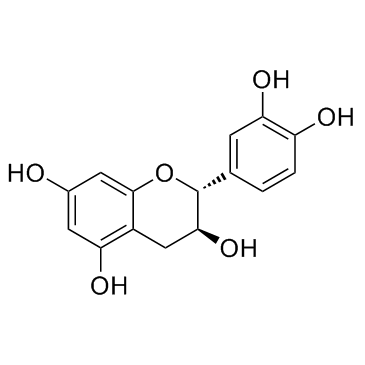
![(2R-trans)-2-[3,4-bis(phenylmethoxy)phenyl]-3,4-dihydro-5,7-bis(phenylmethoxy)-2H-1-benzopyran-3-ol structure](https://image.chemsrc.com/caspic/113/20728-73-8.png)
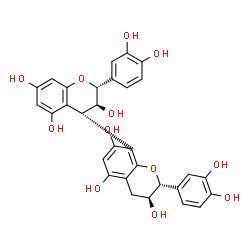
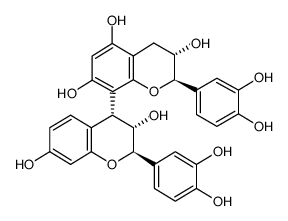
![(2R,3S)-2,3-trans-6-[(2R,3S,4S)-2,3-trans-3,4-trans-3,3',4',7-tetrahydroxyflavan-4-yl]-3,3',4',5,7-pentahydroxyflavan structure](https://image.chemsrc.com/caspic/129/69176-55-2.png)
